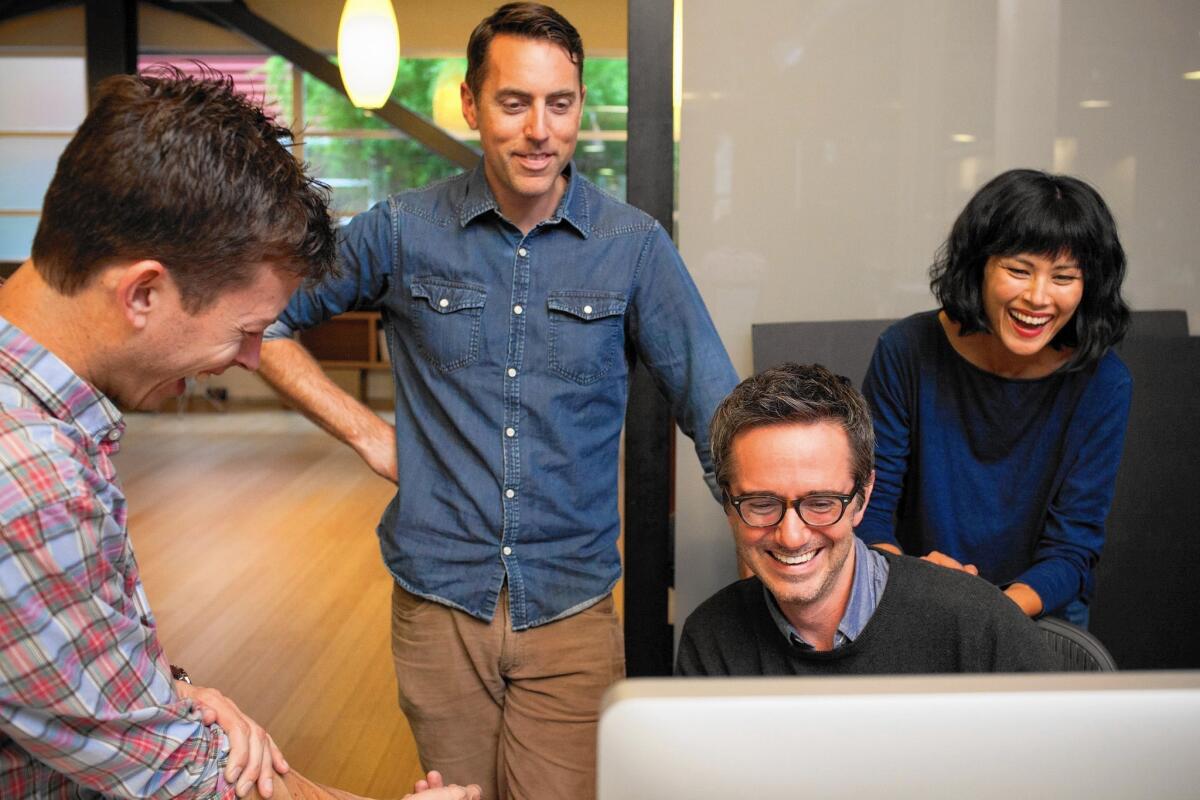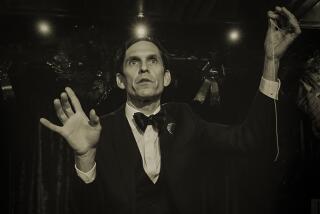Pop-Up Magazine: Live storytelling with no digital footprint

- Share via
The scene was a beautiful, chaotic mess, a mashup of live music, animation and rollicking storytelling for about 2,600 people filling Davies Symphony Hall in San Francisco. So ravenous was the crowd for Pop-Up Magazine’s particular brand of storytelling — original magazine-style nonfiction, told aloud and through still photography, recorded interviews and short films, with many pieces accompanied by live “soundtracks” — that the Nov. 13 event had sold out online in about 15 minutes.
Afterward, the crowd streamed into the lobby rotunda for what some described as a deafening party that went on for hours. The bars were packed with gregarious guests savoring and retelling the stories they had heard.
Which is fortunate, because none of the pieces performed that night exists anymore, except in memory. The event — a version of which premieres in Los Angeles on Wednesday — featured New Yorker journalist Susan Orlean, “This American Life” contributor Starlee Kine and Oscar-nominated filmmaker Amanda Micheli, along with seasoned radio producers and photographers, but it wasn’t recorded. Stories haven’t been uploaded to Pop-Up’s website, nor will they be broadcast or podcasted. And no photographs were taken during the show. If you missed it, you missed out, which was the point.
“It’s ephemeral,” says Pop-Up founder Douglas McGray. “There’s an appeal in seeing something so fleeting. You look around the room and don’t see a single phone light glowing. Afterwards, of course, they all light up and everyone starts tweeting. But there’s a moment when everyone comes together and watches and listens that’s really kind of magical.”
The media landscape is saturated with live storytelling republished in multiple forms. Shows such as the memoir-driven “The Moth” and “Mortified,” the more polished WordTheatre, as well as staged incarnations of public radio shows “This American Life” and “Radiolab,” present stories that typically live on afterward — streamed online, broadcast on the radio or podcasted, collected as audiobooks or in printed anthologies. Pop-Up embodies this spirit of experimentation but is purposefully evanescent and not shareable — an approach some find surprising.
“These days, the gospel is you gotta put it out and find the biggest audience you can in the digital space, grow your brand and generate revenue,” says Lea Thau, producer of KCRW’s “Strangers” podcast and formerly director of “The Moth.” “And to decide to just not do that, I suppose, is radical. But it’s also created this tremendous excitement around their live shows.”
Pop-Up, which holds events two or three times a year, has nearly tripled its audience every year since launching, growing from a 360-seat theater in 2009 to a 900-seat auditorium in 2010 to a 2,600-member audience in 2011. The series also has a sister media product, the California Sunday Magazine, which McGray launched with publisher Chas Edwards in October. The monthly magazine covering the West, Latin America and Asia is distributed digitally as well as in some newspapers including the Los Angeles Times, San Francisco Chronicle and the New York Times in the Bay Area. (It pays for insertion in these papers and its content is produced independently.)
The trajectory is as counterintuitive as Pop-Up itself: Typically, print publications and podcasts launch live shows to broaden their audience base and beef up revenue, not the other way around.
Will the addition of a print publication undercut the uniqueness of Pop-Up as a local, blink-or-you’ll-miss-it, in-person experience?
“They’re just different,” McGray says. “I see it as a way to give people more.”
The California Sunday Magazine may have grown out of the laboratory that is Pop-Up, McGray says, but content-wise, one has little to do with the other, at least for now. The two are owned by McGray and Edwards’ company, California Sunday, which got off the ground with about $2 million from investors. They cross-promote on social media, via email newsletters and at in-person events, and they draw from the same pool of revenue, which includes print and digital advertising, live event sponsorship, ticket sales and reader membership fees.
Beyond that, they’re two very different forms of storytelling, defined largely by where and when they’re consumed. Pop-Up takes place on weeknights, in public art spaces and watering holes like theaters and bars, with friends over drinks; the California Sunday Magazine is meant to be lingered over in print or on tablets at a more leisurely pace, on weekends, perhaps while lounging in bed.
“We’re building both of them side by side,” McGray says. “People who like to come out to Pop-Up, we hope will become readers of California Sunday at home, with their coffee; people who discover our print magazine for the first time in one of the big California newspapers or find us online, we hope they’ll come out and hang with us at a live show.”
The inspiration to start Pop-Up was personal, McGray says. A magazine writer who’s done long-form pieces for the New Yorker and “This American Life,” among other places, McGray became disheartened by how segmented the media world had become. Often, he says, he never even met the photographers who shot his stories. Pop-Up was conceived as a cross-pollinated love letter to nonfiction of all stripes.
“I love the idea of mixing all these worlds together both onstage and in the audience,” McGray says. “And bringing people together around stories.”
Structured like a general interest magazine come to life, Pop-Up opens with brief reviews, mini-profiles, infographics and lists; slightly longer stories fill the “feature well.” McGray asks members of the audience to record nothing and to turn off their phones. The stage is set simply, with readers at a music stand under a spotlight, backed by a large screen for video and graphics.
At a 2009 show, shortly before he died, photographer Larry Sultan narrated images from a photo album he’d found 30 years earlier at a flea market, retelling the life story of a young man who shipped off to war. At another show, “Toy Story 3” director Lee Unkrich used film clips to give a behind-the-scenes look at how he sound-edited a single line of dialogue in the movie. Oscar-nominated documentary filmmaker Sam Green has shown a narrative short about fog in San Francisco, accompanied by live music. Author Michael Pollan and Pulitzer Prize-winning novelist Alice Walker have read nonfiction stories. Pop-Up has even had “special issues,” like an all-music show in 2013, a collaboration with Beck and novelist Dave Eggers’ publishing company, McSweeney’s, that featured live music and stories about music.
A bar party after each show takes the place of a formal Q&A. Guests can mingle with performers and ask questions in a more intimate setting. “And the show draws a unique crowd,” McGray says. “The most interesting person you meet that night might very well be someone from the audience.”
McGray and Pop-Up senior editor Pat Walters, formerly a producer for “Radiolab,” work closely with performers to shape stories. That the show isn’t recorded and works won’t be republished has proved freeing for many participants. Knowing they won’t end up on YouTube allows some to be more experimental.
“The show is an incubator for content,” say Jon Mooallem, whose Pop-Up story about the evolution of the hand-slap known as the high-five grew into a longer piece for ESPN the Magazine. “It gives people freedom to delve into an idea that they otherwise wouldn’t if they thought they had to sell it to a national magazine. It allows you to wonder about things. One piece I did turned into a 25,000-word e-book, ‘American Hippopotamus,’ for the Atavist that came out earlier this year. I had no idea that it could become that at the time.”
The work-in-progress quality is part of the Pop-Up’s appeal, says Davia Nelson, half of the Kitchen Sisters, who will retell an obscure moment from gold rush history for the L.A. show.
“It’s far from perfect, but I think that invites a lot of people in because there’s a hunger for something real, here and now, bearing witness to each other’s stories in real time,” she says. “That’s primal.”
McGray can’t say exactly what will unfold onstage at the L.A. show at the Theatre at Ace Hotel, lest he dilute the element of surprise. About 20 works will be performed. Orlean will read a first-person piece, novelist Rebecca Skloot will share a humorous animal science story, and author and radio personality Jon Ronson will unravel a particular online controversy. KPCC’s Alex Cohen will narrate a piece, weaving recorded interviews, photographs and film clips, about a journey some TV actors find themselves on.
“These guys are master storytellers,” says Found Magazine’s Davy Rothbart, who’s performed at Pop-Up. “The shows are so unique. I mean, who thinks to do a magazine that has no print or online, that just exists in the one night?”
McGray doesn’t see Pop-Up as particularly counter-trend.
“I just think we’re in an experimental time in media,” he says, “and that has us thinking about all the ways you can tell stories and bring people together around them.”
------------
Pop Up Magazine
Where: The Theatre at Ace Hotel, 929 S. Broadway, Los Angeles
When: Doors open 6:45 p.m., show at 7:30 p.m., Wednesday
Tickets: $35 to $50
Info: https://www.popupmagazine.com
More to Read
The biggest entertainment stories
Get our big stories about Hollywood, film, television, music, arts, culture and more right in your inbox as soon as they publish.
You may occasionally receive promotional content from the Los Angeles Times.











